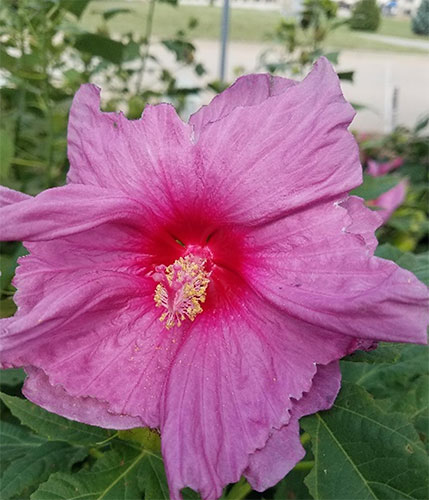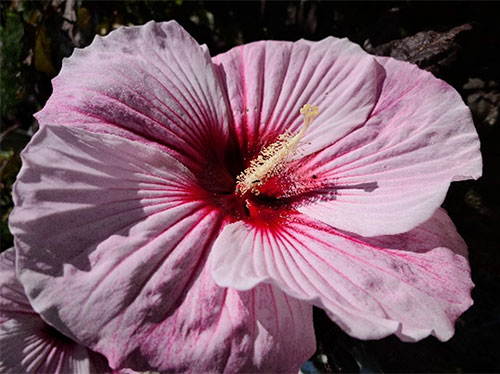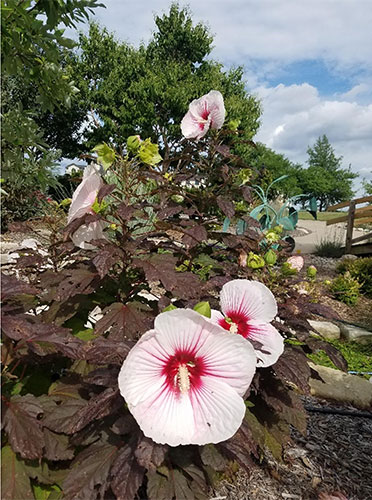Hardy Hibiscus Add A Splash of Summer Color
 Are you seeking a tropical look in the garden that includes the added benefit of a perennial plant that will return each summer? Look no further than the hardy hibiscus. Each summer, flashy dinner plate sized blooms offer a stunning pop of color in a variety of sizes and shapes. Best of all, the plant is almost carefree.
Are you seeking a tropical look in the garden that includes the added benefit of a perennial plant that will return each summer? Look no further than the hardy hibiscus. Each summer, flashy dinner plate sized blooms offer a stunning pop of color in a variety of sizes and shapes. Best of all, the plant is almost carefree.
Hardy hibiscus should not be confused with its cousin, the tropical hibiscus. With shiny green foliage, the tropical hibiscus makes a great patio plant with bright yellow, orange, pink or red flowers. But they will not survive winter outdoors in the Midwest as they are truly tropical.
Hardy hibiscus are also known as Rose Mallow and Perennial Hibiscus. It is sometimes confused with the shrub Rose of Sharon. All of these are hibiscus, but different species.
Hardy hibiscus is a perennial, and returns each spring from a thick, fleshy crown. They love the summer heat, and they are slow to emerge in the spring. Be patient and don’t give up on them as it might be well into May before any growth appears, especially if we had a late, cooler spring.
 Hardy hibiscus lives up to its name as it is not particularly fussy about soil conditions. This versatile plant will even grow in boggy soil. Good soil moisture is best for flowering, but they are drought tolerant as well. Hibiscus can survive with little or no supplemental irrigation.
Hardy hibiscus lives up to its name as it is not particularly fussy about soil conditions. This versatile plant will even grow in boggy soil. Good soil moisture is best for flowering, but they are drought tolerant as well. Hibiscus can survive with little or no supplemental irrigation.
Like most summer blooming plants, full sun is the desired location in the garden. Light shade will decrease flowering.
Yearly care is simple. Cut the thick woody-like stems to the ground after they go dormant in the fall or late winter. Sit back and patiently wait for the new growth and flowers to develop in mid-July and last well into August.
Older varieties of hardy hibiscus, Lord and Lady Baltimore, are large, rangy plants. Breeders have shrunk the plant, creating more compact, desirable garden cultivars.
 Newer varieties can range from two to three feet up to five feet in height and width. Strong stems develop a well-rounded plant terminating in showy flowers reaching 10 inches or more across. Flower colors range from a luscious soft to moody dark pink, an array of red shades, white, and variegated bicolors mixing the various hues.
Newer varieties can range from two to three feet up to five feet in height and width. Strong stems develop a well-rounded plant terminating in showy flowers reaching 10 inches or more across. Flower colors range from a luscious soft to moody dark pink, an array of red shades, white, and variegated bicolors mixing the various hues.
Leaf colors vary from green, to a greenish gray, to maroon. Some leaves have a dull matt, while others develop more of a sheen. Leaf shape varies from an oval to a lobed form, adding more textural interest.
Breeding and the release of new varieties has prompted a comeback. It is easy to be overwhelmed by the selections. A few favorites are Berry Awesome, Cranberry Crush, Perfect Storm, Cherry Cheesecake, Midnight Marvel, Starry Starry Night and Peppermint Schnapps. Those who named the plants get an A+ for creativity.
Add one of these new varieties in your garden today. Full-grown flowering plants are found at local garden centers. It is a great way to add an immediate impact statement in the garden.
This is almost the perfect plant, however, there can be one downside. Japanese beetles like to munch on the showy flowers. They can destroy the perfect structure of the flower when viewing up-close. Even with the beetle nibbles, damage is temporary. These bold, cheerful blooms will still put a smile on your face in the heat of summer.
No perennial garden is complete without at least one hardy hibiscus to shine during the heat of summer.